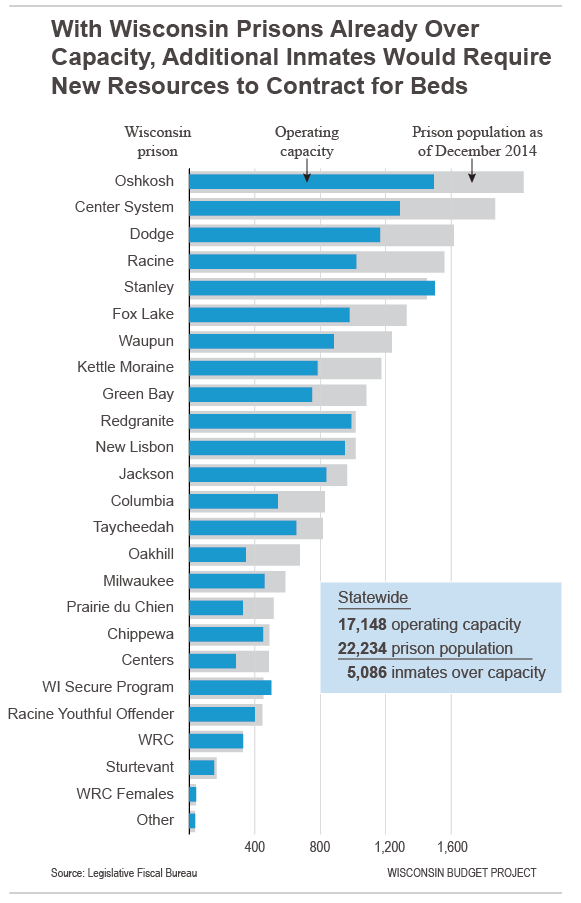Will Counties Handle State’s Prisoners?
State prisons are way over capacity; officials propose contracting with county jails.
![Columbia Correctional Institution. Photo by Dual Freq (Own work) [CC BY-SA 3.0 (http://creativecommons.org/licenses/by-sa/3.0) or GFDL (http://www.gnu.org/copyleft/fdl.html)], via Wikimedia Commons.](https://urbanmilwaukee.com/wp-content/uploads/2016/08/Columbia_Correctional_Institution_Wisconsin_with_guard_tower.jpg)
Columbia Correctional Institution. Photo by Dual Freq (Own work) [CC BY-SA 3.0 (http://creativecommons.org/licenses/by-sa/3.0) or GFDL (http://www.gnu.org/copyleft/fdl.html)], via Wikimedia Commons.
Earlier this year, state lawmakers passed a law increasing the severity of the offense of the fourth and subsequent instances of driving while intoxicated. The change means that more people will be sent to prison for repeat instances of drunk driving; the Department of Corrections estimates the new law will increase the number of inmates in the state prison system by 458 inmates at the end of 2017, and by 1,205 inmates at the end of 2018. The increase in the number of inmates is expected to continue to rise after the second year and then level off at some point.
Absorbing those additional inmates will be difficult because Wisconsin prisons are already significantly overcrowded. Wisconsin’s prison system was designed to house 17,148 inmates – but it held 22,234 inmates as of the end of 2014, more than 5,000 inmates over capacity. The state’s largest prison, the medium-security prison in Oshkosh, has an operating capacity of 1,494 but held 2,044 inmates. That’s 550 inmates over capacity, or 37% more residents than the facility is meant to hold. To fit more inmates into prisons than was originally intended, officials have put more inmates into cells than the cells were designed for, and used non-housing space for housing purposes.

With Wisconsin Prisons Already Over Capacity, Additional Inmates Would Require New Resources to Contract for Beds
By filling state prisons beyond capacity, state officials have managed to limit the financial cost of locking up the increasing number of people – although of course this approach also comes with a number of downsides, such as reducing the space available for programs or activities that can help inmates integrate back into their communities once they are released.
Now, however, prison officials have said that they cannot fit any more inmates into the state’s prison system, including the projected increase in inmates from the change in repeat drunk driving laws. As Department of Corrections officials noted in the department’s 2017-19 budget request: “Due to current prison populations, space does not exist in Department of Corrections institutions to house and provide programming for the additional projected population.”
The costs incurred by filling the state’s prison system beyond capacity should be an impetus to lawmakers to find alternatives that reduce the number of people locked up by the state. Wisconsin’s corrections costs are already out of line with those in other states. Prison Price Tag: The High Cost of Wisconsin’s Corrections Policies, a Wisconsin Budget Project report, explains how Wisconsin’s corrections costs line up:
Wisconsin state and local governments spent $1.5 billion on corrections in 2013. That’s over a tenth more — 12% — on corrections per state resident than the national average, according to U.S. Census Bureau figures from 2013, or $27 more per state resident. Nationally, only 11 states spend more on corrections per state resident than Wisconsin.
Some other states – such as New Jersey, California, and New York – have successfully reduced corrections costs by driving down prison populations while still keeping crime rates low. Wisconsin could follow in the footsteps of other states and reduce corrections populations and costs by:
- Expanding approaches that have proven track records for keeping people out of prison;
- Reducing the number of prison admissions that do not involve new convictions; and
- Reducing recidivism by removing barriers to getting a job.
We won’t be able to undo years of overuse of the state’s prison system overnight. But by the Department of Corrections’ budget request shows the importance of moving the emphasis from high-cost incarceration to less expensive alternatives.
Wisconsin Budget
-
Charting The Racial Disparities In State’s Prisons
 Nov 28th, 2021 by Tamarine Cornelius
Nov 28th, 2021 by Tamarine Cornelius
-
State’s $1 Billion Tax Cut Leaves Out 49% of Taxpayers
 Sep 21st, 2021 by Tamarine Cornelius
Sep 21st, 2021 by Tamarine Cornelius
-
TANF Program Serves a Fraction of Poor Families
 Aug 30th, 2021 by Jon Peacock
Aug 30th, 2021 by Jon Peacock





















First, change the laws so that inmates serving time for nonviolent drug offenses are drastically reduced, especially for marijuana.
Would it not cost less, and be more humane, to have more drug and alcohol treatment outside of prisons? If the medical profession calls it an illness, why are why imprisoning addicts–and doing little to actually provide treatment?
The drunken driver offenders should have their cars taken and sold to pay for transportation with taxis and Uber to go to their jobs. This would take the drunken drivers off the roads to protect society and allow the drunken driver offenders to continue working with limitations. New laws need to be made for the repeative drunken drivers.
New laws will create a safer society and create new jobs and revenue for court processing from the sale of the repeative drunken drivers.
Ideas worth sharing.
I agree, why do addicts have to be stuffed in a cell and have to sleep on the floor…it is a disease. obviously most are harmless just wanting help and deserving of it. the guards treat them so inhumane its pathetic ! there are other alternatives such as house arrest, tracking bracelet, etc. Say what you want but all prisoners are still human beings and still deserve to have their dignity, and heaven forbid you say anything because it does no good only gets your loved one treated worse.
the way they check visitors there is no way to get drugs in the facility, so where do we think they are coming from ? perhaps
the guards themselves so the inmate has to be degraded and kiss their asses to get a extra book or a phone call.